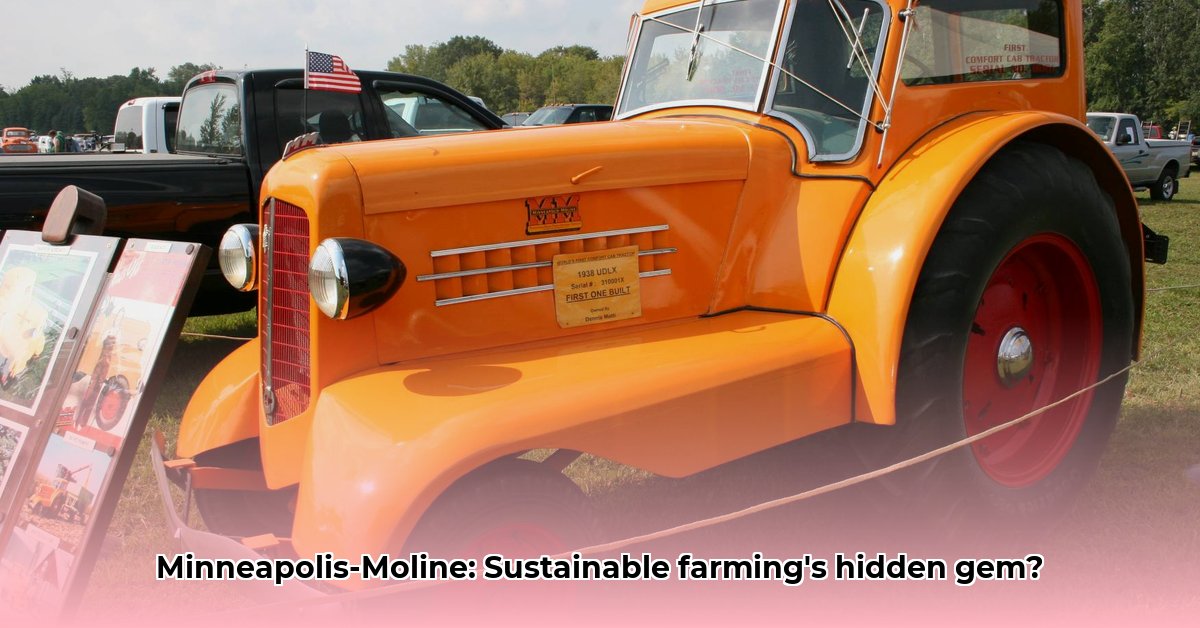
The rumble of a classic Minneapolis-Moline (M-M) tractor evokes a bygone era of American agriculture. More than just gears and engines, the M-M story is a compelling narrative of innovation, resilience, and the enduring impact of agricultural technology on both farmers and the environment. This journey explores M-M's history, key innovations like the UDLX Comfotractor, its eventual decline, and its lasting legacy within the context of sustainable farming practices. Did the pursuit of efficiency inadvertently contribute to environmentally sound practices? Let's delve into the fascinating details. For more information on M-M history, visit the Moline Tractor website.
Minneapolis-Moline's Rise: A Merger of Giants
The 1929 merger of Minneapolis Steel & Machinery, the Minneapolis Threshing Machine Company, and the Moline Plow Company birthed Minneapolis-Moline. This wasn't a simple consolidation; it was a strategic fusion aimed at revolutionizing farming. The newly formed entity didn't merely aim to produce tractors; it envisioned transforming the arduous, labor-intensive work of agriculture into a more streamlined, efficient process, capable of feeding a rapidly expanding nation. How well did they succeed?
Early Innovations and Their Impact
M-M's early tractors were robust workhorses, built to endure the harsh realities of farm life. Farmers, many still reliant on animal power, quickly recognized the transformative potential. Planting, tilling, and harvesting became less physically demanding and exponentially faster. But what was the environmental cost of this efficiency? How did the early M-M tractors affect soil health and fuel consumption compared to the oxen and horses they replaced? The answer requires nuanced research, examining not just the machinery itself but the broader context of evolving agricultural practices.
The UDLX Comfotractor: A Paradigm Shift in Operator Comfort
The UDLX Comfotractor, arguably M-M's most influential creation, represents a pivotal moment. Prior tractors were notoriously uncomfortable, leading to operator fatigue and reduced efficiency. The UDLX, however, incorporated features like a significantly improved seat and more ergonomic controls. It directly reduced operator fatigue enabling longer workdays and increased productivity. This design philosophy directly contributed to improved farming efficiency. But did this increase in efficiency come at the cost of increased fuel usage and emissions? A deeper examination is warranted. What is clear is that improving the comfort of the farmer translated directly to increased output.
Navigating the Changing Landscape: Challenges and Decline
Despite initial success and innovative designs, M-M faced significant headwinds. The agricultural landscape evolved rapidly. New competitors emerged, offering alternative technologies and business models. Economic fluctuations and industry consolidation also challenged the company's position as an independent entity. M-M's story isn't purely one of success, but it highlights the adaptability required to thrive in a dynamic sector. Could a more proactive approach to sustainability have prolonged the company's existence?
The Enduring Legacy: Examining Sustainability Through a Retrospective Lens
The M-M legacy extends beyond mere numbers of tractors produced. Its impact on farming methods and the lives of farmers remains undeniable. However, the contemporary focus on sustainability demands a critical examination of its environmental impact. What were the long-term environmental consequences of M-M's fuel consumption? Were the company's manufacturing processes environmentally responsible by today's standards? These are crucial questions for scholars, researchers, and preservationists. This examination becomes a case study of the complexities of environmental sustainability in agricultural innovation.
Research, Preservation, and the Future of Sustainable Farming
Fully comprehending the environmental impact of M-M tractors necessitates extensive research. Lifecycle assessments comparing M-M models to their contemporaries and modern equivalents are crucial. This collaborative endeavor will involve agricultural historians, museum curators, environmental scientists, and engineers. Preserving these historic machines is equally vital. Collectors and enthusiasts are already actively involved in restoration, keeping a tangible piece of agricultural history alive. This effort should be further supported by museums and historical societies, transforming historical tractors into valuable educational tools.
A Collaborative Path Forward: Preserving History, Shaping the Future
Understanding the true impact of Minneapolis-Moline tractors on sustainable farming demands a collective effort. Various stakeholders must contribute to a more comprehensive understanding of the historical and environmental context:
Agricultural Historians: Detailed analysis of M-M records and documents is critical to understanding context and practices.
Museum Curators: Acquiring and preserving M-M tractors for future generations ensures a legacy of knowledge.
Sustainable Agriculture Researchers: Conducting life-cycle assessments of various models will provide vital environmental data.
Collectors and Restorers: Maintaining and restoring these machines not only preserves history, but also facilitates further research.
The story of Minneapolis-Moline tractors serves as a compelling reminder that agricultural innovation is an ongoing process. It's about more than just building increasingly efficient machines. It's about fostering sustainable practices that benefit both farmers and the environment. The legacy of M-M is still unfolding, and it's our responsibility to learn from its past to build a more sustainable future.